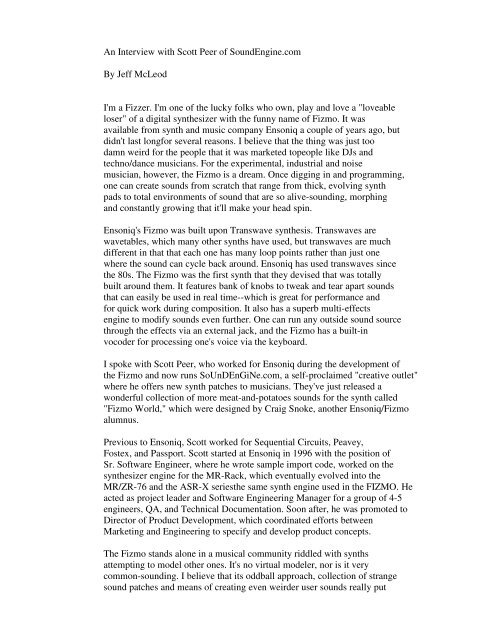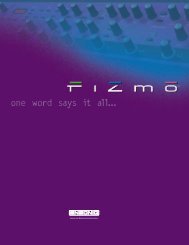An Interview with Scott Peer of SoundEngine.com By ... - Ugo Audio
An Interview with Scott Peer of SoundEngine.com By ... - Ugo Audio
An Interview with Scott Peer of SoundEngine.com By ... - Ugo Audio
- No tags were found...
You also want an ePaper? Increase the reach of your titles
YUMPU automatically turns print PDFs into web optimized ePapers that Google loves.
<strong>An</strong> <strong>Interview</strong> <strong>with</strong> <strong>Scott</strong> <strong>Peer</strong> <strong>of</strong> <strong>SoundEngine</strong>.<strong>com</strong><strong>By</strong> Jeff McLeodI'm a Fizzer. I'm one <strong>of</strong> the lucky folks who own, play and love a "loveableloser" <strong>of</strong> a digital synthesizer <strong>with</strong> the funny name <strong>of</strong> Fizmo. It wasavailable from synth and music <strong>com</strong>pany Ensoniq a couple <strong>of</strong> years ago, butdidn't last longfor several reasons. I believe that the thing was just toodamn weird for the people that it was marketed topeople like DJs andtechno/dance musicians. For the experimental, industrial and noisemusician, however, the Fizmo is a dream. Once digging in and programming,one can create sounds from scratch that range from thick, evolving synthpads to total environments <strong>of</strong> sound that are so alive-sounding, morphingand constantly growing that it'll make your head spin.Ensoniq's Fizmo was built upon Transwave synthesis. Transwaves arewavetables, which many other synths have used, but transwaves are muchdifferent in that that each one has many loop points rather than just onewhere the sound can cycle back around. Ensoniq has used transwaves sincethe 80s. The Fizmo was the first synth that they devised that was totallybuilt around them. It features bank <strong>of</strong> knobs to tweak and tear apart soundsthat can easily be used in real time--which is great for performance andfor quick work during <strong>com</strong>position. It also has a superb multi-effectsengine to modify sounds even further. One can run any outside sound sourcethrough the effects via an external jack, and the Fizmo has a built-invocoder for processing one's voice via the keyboard.I spoke <strong>with</strong> <strong>Scott</strong> <strong>Peer</strong>, who worked for Ensoniq during the development <strong>of</strong>the Fizmo and now runs SoUnDEnGiNe.<strong>com</strong>, a self-proclaimed "creative outlet"where he <strong>of</strong>fers new synth patches to musicians. They've just released awonderful collection <strong>of</strong> more meat-and-potatoes sounds for the synth called"Fizmo World," which were designed by Craig Snoke, another Ensoniq/Fizmoalumnus.Previous to Ensoniq, <strong>Scott</strong> worked for Sequential Circuits, Peavey,Fostex, and Passport. <strong>Scott</strong> started at Ensoniq in 1996 <strong>with</strong> the position <strong>of</strong>Sr. S<strong>of</strong>tware Engineer, where he wrote sample import code, worked on thesynthesizer engine for the MR-Rack, which eventually evolved into theMR/ZR-76 and the ASR-X seriesthe same synth engine used in the FIZMO. Heacted as project leader and S<strong>of</strong>tware Engineering Manager for a group <strong>of</strong> 4-5engineers, QA, and Technical Documentation. Soon after, he was promoted toDirector <strong>of</strong> Product Development, which coordinated efforts betweenMarketing and Engineering to specify and develop product concepts.The Fizmo stands alone in a musical <strong>com</strong>munity riddled <strong>with</strong> synthsattempting to model other ones. It's no virtual modeler, nor is it very<strong>com</strong>mon-sounding. I believe that its oddball approach, collection <strong>of</strong> strangesound patches and means <strong>of</strong> creating even weirder user sounds really put
people <strong>of</strong>f when it was released. <strong>Scott</strong> has unique insight into the Fizmo,it's concept, uniqueness and untimely demise.1. What was the creative spark behind the conception <strong>of</strong> the Fizmo? Whatwere the original ideas for this synthesizer?Originally, FIZMO was referred to as PHYS-MO. Bill Mauchly (Ensoniq ChiefScientist) and I were talking about developing a synthesizer around a chipcalled the OTTO-FX. Which <strong>com</strong>bined the ASR-10 Synth Engine and EffectsEngine on one piece <strong>of</strong> silicon. This chip never shipped in a <strong>com</strong>mercial MI(Musical Instrument) product.What eventually evolved was a product based upon Transwaves, which I felt werethe most <strong>com</strong>pelling new sound synthesis technology that Ensoniq had in hand.Things really started to happen after Waveboy (aka the aforementioned BillMauchly) and Soundengine.<strong>com</strong> (aka me) independently released two transwaveproducts for the ASR-10.2. When the idea for the synth was pitched to Ensoniq what was the response?The idea <strong>of</strong> a transwave synth was pitched to Ensoniq management. I was Director<strong>of</strong> Product Development at the time, so my role was essentially to generateconsensus among Engineering and Marketing Management. I convinced theDirector <strong>of</strong> Marketing, the VP <strong>of</strong> sales and marketing, and the VP <strong>of</strong> M.I.Engineering that this was financially viable product, and we got started.3. How was the Fizmo to be marketed?As a non-"me too" analog simulation synthesizer. The notion was that itinitially would have more appeal in Europe (<strong>with</strong> all <strong>of</strong> the dance music beingwritten there) than in the US.4. How long was it actually on the market before being discontinued?It was actively marketed for about six months. Around the time FIZMO was to bereleased, Creative Labs, in their infinite wisdom, decided to merge the EnsoniqMI division <strong>with</strong> Emu.There is an entire story here, <strong>with</strong>in the merger.
Emu and Ensoniq were culturally, *<strong>com</strong>pletely* different, and in<strong>com</strong>patible<strong>com</strong>panies. From my perspective, Ensoniq was more <strong>of</strong> a "get it out the door"<strong>com</strong>pany, whereas Emu was a "we have a formula" <strong>com</strong>pany, which made the mergerdifficult. Ensoniq, the engineering and marketing teams, and all <strong>of</strong> ourproducts, did not fit into the Emu formula.Ensoniq was also quite different in how decisions were made. Consensus was theapproach on the East Coast, while closed door <strong>of</strong>fice politicking was the methodat Emu.5. Why was it discontinued?IMHO, Emu didn't get it, and at that point, some other events had happened atEnsoniq/Creative where it didn't matter that much. Creative Labs decided topull all <strong>of</strong> the engineers that were working on MI products in Malvern (Ensoniq)back onto Sound Card, Video Card and other Multimedia related products. Theengineers who remain at 155 Great Valley Parkway, Malvern are still doing this.The <strong>com</strong>pany line on this transition was that the Ensoniq MI Engineering was"too valuable" to leave <strong>with</strong>in Emu control, because Creative believed that Emuwas failing, and would be absorbed into other divisions soon. Personally, I didn'tbuy the <strong>com</strong>pany line, as the Emu Engineering team most certainly was astalented as ours, they just worked <strong>with</strong>in the political system that existed atEmu. I believe the Ensoniq MI return to Multimedia projects was purely apolitical power play at the Creative Labs US level. But anyway, it's all historynow, and in the long run, it really doesn't matter.FIZMO has a history <strong>of</strong> defects because <strong>of</strong> one simple reason. It wasmanufactured by a team <strong>of</strong> people (the Creative Labs MalvernManufacturing Team) that were frankly, tired <strong>of</strong> making keyboards. They weremore focused on seeing the hundreds <strong>of</strong> thousands <strong>of</strong> <strong>Audio</strong> and Graphics PCcards go down the product line. Keyboards were much more bothersome to build,because there is much more craftsmanship involved. As I understand it, most <strong>of</strong>the FIZMO related defects are power supply related, which meansthat it's likelythat an inferior supplier was chosen for cost reasons.6. What do you think were the reasons for it not being very popular? Pleasetouch on some <strong>of</strong> the "Fizmo Bashing" that's very evident on synth reviewarchive sites on the internet and what you think about that and its origins.I think the main reasons behind the FIZMO bashing are two-fold:
[1] For some reason, the message about it *not* being a virtual analog synthwasn't related well enough, and when customers tried it out, they couldn't findthe TB-303 patch or the "Jump" patch.[2] I think the factory set <strong>of</strong> presets is a bit too "evolutionary" in nature.What I mean by this is that I have seen the typical way people normally try outsounds on a keyboard in a music store. They have one hand on the "+ Preset+button, and the other on the keyboard. If the sound they select doesn't hithome <strong>with</strong>in 1-2 notes, they hit "+ Preset." This method <strong>of</strong> course, doesn't let thedynamic, synthetic, transwave technology be heard in FIZMO. Try selectingsounds this way - I think you'll agree.7. What do you think are the most innovative and unique things about the Fizmo?What got overlooked?Transwaves, audio processing through the best sounding effects in the business.8. What do you think are its most detrimental attributes? What really hurt itschances <strong>with</strong> users.I think if I had the opportunity to design it again, I would include an LCD display<strong>with</strong> text characters.9. Tell me a bit about <strong>SoundEngine</strong>.<strong>com</strong> and what your mission<strong>with</strong> that <strong>com</strong>pany is.SoUnDEnGiNe.<strong>com</strong> has been around since 1991! At Peavey, where I worked in alife prior to Ensoniq, my employment agreement laid claim to *all* materials thatI developed there, including any sound programming that I did at home. I didprograms for all <strong>of</strong> the synths I designed at Peavey, as well as at SequentialCircuits, where I worked before that. I always wanted to have a sounddevelopment <strong>com</strong>pany, and when the Internet started to take <strong>of</strong>f, it was a naturalvenue for me to market what I had created.SoUnDEnGiNe.<strong>com</strong> now has evolved into something much more. I view it as acreative outlet for me, and an opportunity for sound developers worldwide toapply what I have learned in participating in online sales for 9 years, to markettheir sounds. I am fortunate to work <strong>with</strong> *extremely* talented sound developersfrom Australia, Germany, the Netherlands and the US. I <strong>of</strong>fer a more generousroyalty than other sound development houses. I look at SoUnDEnGiNe.<strong>com</strong> as acollective. With that perspective, the last two years have been the most
ewarding in the <strong>com</strong>pany's history.10. Why have you released a new collection <strong>of</strong> patches for the Fizmo? Isthere a renewed interest in this synth?I don't know if there is renewed interest. Craig Snoke and I have maintained afriendship since we both left Ensoniq, and this was something he wanted to bringto market. Good thing he did - sales have been great!11. Why do you feel that many experimental and industrial musicians haveembraced the Fizmo?Short answer: because they get it. They held Middle C on the keyboard for morethan 1 second, and tweaked the knobs rather than press the "+ Preset" button. Iapplaud them. They understand that FIZMO is a <strong>com</strong>pletely unique soundingsynthesizer. Joe Kramer, the former product manager for FIZMO at Ensoniq and Ijoke that in 2005, FIZMO will be as valuable as TB303's were two years ago,because they are so rare and unique - a cult classic.12. With all the modeling devices popping up every day, there seems to bea revival <strong>of</strong> synthesis lately. Please share your thoughts on this.We were discussing this the other day. I agree that there is more synthesis outthere. Call me a dinosaur (and to some degree, I call myself one), but I thinkmost <strong>of</strong> what is considered "the revival" in synthesis is s<strong>of</strong>tware basedproducts. This technology sounds good, but being the Brontosaurus that I am,it's not fun nor interactive enough for me to tweak virtual knobs on a CRT. Iwant the buttons and lights. They are what keeps me interested enough that Ilook up at the clock and realize is 1:30am.




